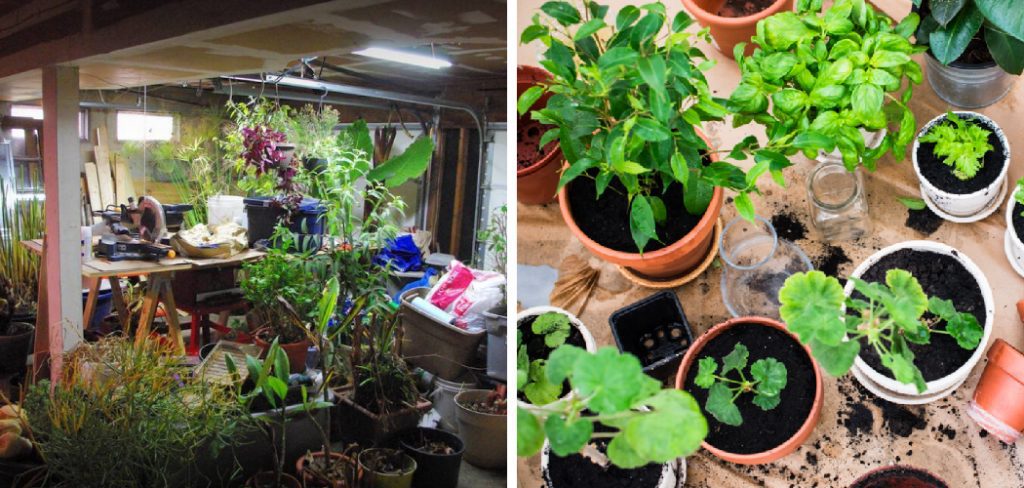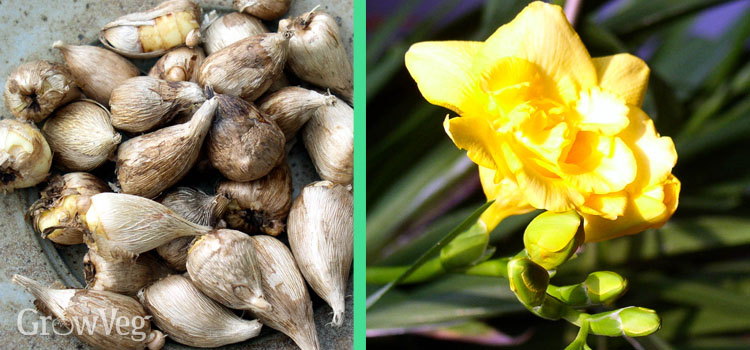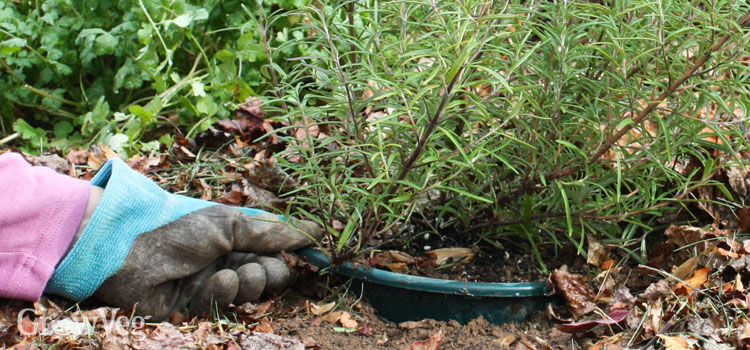It surprises me every year at this time how many different containers have gathered in my basement to stay safe over the winter. For ten years, I’ve been growing amaryllis bulbs. This year, I have shamrock (oxalis) that grew outside all summer and pots of chives, rosemary, and sage that have had their stems cut back. Without much care, they will be safe and happy there all winter, even though it is cold and dark.
I’ve enjoyed putting plants to sleep for the winter in garages and other cold places for a long time. There have been many successes and some failures. Here are some things I learned the hard way about how to keep plants alive over the winter in a garage or basement:
Bringing potted plants into the garage for the winter is a great way to protect them from freezing temperatures, But how long can plants safely stay in the garage before they start to decline? Here’s what you need to know about overwintering plants in the garage,
Why Put Plants in the Garage for Winter?
Many gardeners move potted plants into an unheated garage for the winter months. This protects tender plants that would not survive hard freezes outdoors. It also gives marginally hardy plants an extra layer of protection.
The temperatures in most garages range from 35-50°F in winter. This cool but above freezing environment keeps plants dormant so they survive. But it doesn’t allow active growth.
Plants that do best when overwintered in the garage include
- Tropical plants like hibiscus, mandevilla, and citrus trees.
- Marginally hardy plants like roses, butterfly bush, and hydrangea.
- Bulbs like dahlias, cannas, and gladiolus.
- Perennials and shrubs that need winter protection in containers.
The garage prevents damage to the roots and crowns. It’s an easy way to save plants from year to year.
Factors That Affect How Long Plants Last in the Garage
Several variables impact how long plants can stay healthy in a garage environment
Garage Temperature
-
The cooler the garage, the longer most plants remain dormant and viable. Temperatures closer to freezing keep plants in a preserved state.
-
Warmer garages above 50°F may cause some plants to break dormancy too early. This stresses them when they must go back outside.
Light Levels
-
Most dormant plants need very little light while in the garage. But some may start to grow if exposed to windows or artificial lights.
-
Low light levels are better to keep tropical plants and perennials dormant. Avoid light fixtures that could switch on.
Humidity
-
Heated garages tend to be drier inside. Extra humidity from humidifiers or damp surfaces helps maintain dormant plants.
-
Drier garages require less frequent watering to prevent desiccation. Too much moisture causes fungal issues.
Plant Type
-
Tropical plants often keep growing semi-actively and need more ideal conditions. They decline faster than fully dormant plants.
-
Perennials with large roots and plant crowns fare better long-term than tender annuals and small rooted plants.
-
Bulbs and tubers last longest with minimal water and cool stable temperatures around 40°F.
Signs It’s Time to Move Plants Out of the Garage
After an extended period, all garage-stored plants start to deteriorate. Signs it’s time to move them back outdoors include:
- Leaves yellowing or browning from lack of light.
- Wilting or limp foliage caused by dry air.
- Leaf drop and loss of lower leaves as plants use up reserves.
- Leggy, weakened growth from warm temperatures.
- Mold or rot issues on stems and soil surface.
- Pest infestations like whiteflies, mealybugs, and fungus gnats.
These symptoms typically start showing up after 4-6 months in the garage. Tropical plants or those kept in warmer, humid garages may start declining after just 2-3 months.
The goal is to get plants back outside once daytime temperatures are reliably above 50°F. This prevents further decline.
Best Practices for Keeping Plants in the Garage
Here are some tips to help plants survive as long as possible when overwintering in the garage:
-
Select a cooler area away from appliances that give off heat. Avoid temperature fluctuations.
-
Check plants weekly and water only when soil is partly dry. Too much moisture causes issues.
-
For dormant plants, avoid excess light that could break dormancy too soon.
-
Monitor for pests like whiteflies and spray early with insecticidal soap spray.
-
Prune off dead leaves or stems to improve appearance and reduce pests.
-
Move plants outside on mild days late winter/early spring to reacclimate them.
-
Start hardening off plants in April by keeping them outside during the daytime.
How Long is Too Long in the Garage?
Most hardy plants can be kept dormant in an unheated garage for 4-5 months through the winter. Tropical plants often decline after 2-3 months.
Here are general guidelines for maximum time in the garage by plant type:
-
Tropical plants – 2-3 months max before leaf loss and decline occurs. Citrus may last a bit longer.
-
Summer bulbs – 4-5 months is ideal, until early spring growth begins. Discard bulbs if they start sprouting early.
-
Hardy roses – 4-5 months, but get them outside once daytime temps are above 50°F to avoid leggy growth.
-
Hardy perennials – 4-5 months; sometimes up to 6 months if kept cool and moist.
-
Shrubs/trees in containers – Max of 5-6 months for hardy varieties that need winter protection.
The most important thing is listening to your plants. Move them back outside once you see signs of decline rather than sticking to a fixed timeframe. With proper care, most plants can stay in good shape for a few months until winter passes. Just be ready to transition them back outside in spring!

Tackle Overwintering Pests Promptly
Some pests can stay on plants over the winter, so it’s important to cut off any dead leaves before storing them. Keep an eye out for spider mite webs, which can make a mess of strawberries that are just resting with a few leaves on them. Take the plant away from other plants right away if you see spider mites or any other pest. This will stop the pest from spreading.

Avoid Temperature Fluctuations
Covering all of your pots with an old blanket or flannel sheet will make it easier to know when to water them. Also cover the plants when you temporarily heat the space for other uses. A cloth cover will reduce temperature changes and block light that might confuse the resting plants.

How To OVERWINTER POTTED PLANTS Easier Than Bringing Plants Indoors
FAQ
Will my plants survive in the garage?
Will an unheated garage protect plants from frost?
Can I leave my plants for 5 days?
How long can you keep plants indoors?
Can you store potted plants in a garage?
If you have potted plants that you want to keep alive during the winter months, you may be wondering if it is possible to store them in your garage. The answer is yes! Storing potted plants in your garage for the winter can be a great way to protect them from the cold temperatures and harsh weather conditions.
Can a perennial grow in a garage?
Perennials and shrubs that are in your zone or one colder can be overwintered in an unheated garage, buried in the ground, or transplanted. 3. Perennials and shrubs in containers will need water through the winter but should not be kept wet.
How do you store plants in a garage?
The key to success with garage storage is that this area is attached to the house but not heated. The garage never goes below 32 degrees but tends to hover in the 40’s and low 50’s all winter. This keeps the plant dormant but the plants never freeze. Watering is needed, but not too much or too often.
How to keep plants warm in a garage?
Cover the Plants: To protect the plants from cold temperatures and drafts, it is important to cover them with a light blanket or sheet. This will help to keep the plants warm and prevent them from drying out. 5. Monitor the Temperature: It is important to monitor the temperature in the garage to ensure that it does not drop below 40°F.
Can hibiscus grow in a garage in winter?
If your garage goes much below 50 degrees in the winter you’re better off keeping the Hibiscus in the house. Some plants do fine in the 35 to 50 range of the typical unheated garage, but tropicals don’t do well below 50. Hibiscus is one that does better indoors where the temps are warmer. I am in zone 4. Winter is quite harsh here.
How do you move plants in a garage?
Move the Plants: Once you have determined that the temperature in the garage is suitable for your plants, you can begin to move them. Make sure to handle the plants carefully, as they can be easily damaged. If possible, move the plants in their pots, as this will help to keep the roots intact.
- The Ultimate Guide to Growing Strawberries in Raised Beds - August 8, 2025
- No-Dig Garden Beds: The Easiest Way to Grow a Beautiful Garden - August 6, 2025
- How to Protect and Preserve Wood for Raised Garden Beds - August 6, 2025
